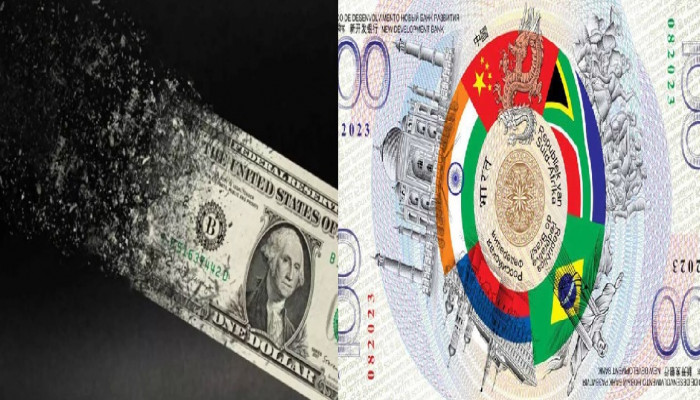BRICS Currency and Dedollarisation
- In Economics
- 09:21 AM, Aug 19, 2025
- Khushi Mishra & Dr. A. Adityanjee
Introduction
When a 70-year-old financial empire begins to crack, watch how swiftly the world rethinks money. For decades, the US dollar stood unchallenged as the backbone of global finance as the international reserve currency. Despite delinking from the gold standard in 1971, the dollar maintained its hegemony in international trade and finance because of the US geopolitical clout. But in 2025, the mood in the Global South has shifted. On a geopolitical chessboard riven by unpredictable tariffs, unilateral financial sanctions, and weakening trust, the BRICS bloc is no longer merely hedging its bets. Still, it is willing to rewrite the rules of international finance, challenging an order the United States has long dominated.
BRIC - coined initially as an acronym for Brazil, Russia, India, China, - once a loose acronym for emerging economies, has transformed into the BRICS Plus. Initially perceived as an inconsequential grouping fraught with internal inconsistencies, BRICS Plus has now emerged as a political and economic force representing over half the world’s population and GDP, surpassing that of the G7. It is no longer debating the idea of alternatives in academic circles. It is taking concrete steps to reduce the dollar’s hegemony. The one single country that has contributed majorly to this push for de-dollarisation happens to be the US.
The US government has indulged in quantitative easing on numerous occasions, printing dollars at the drop of a hat, to safeguard its own mercantile interests. Unilateral decision in 2022 to exclude the Russian Federation from the SWIFT network (a global messaging system used for financial transactions mainly under US and European oversight) catalysed the process of finding international monetary alternatives to the dollar’s hegemony. This process is not an overnight revolution but a slow, reactive, deliberate restructuring of how other countries trade, invest, and settle their accounts. The drivers of the change are as much geopolitical as economic, rooted in the tensions of a more fragmented, multipolar world.
Diverging Positions Within BRICS
The push has many triggers.
- In February, Brazilian President Luiz Inácio Lula da Silva bluntly stated that while Brazil would not pursue a unified BRICS currency for now, it could not keep relying on the “mighty” dollar forever. His comments came after US President Donald Trump threatened steep tariffs on BRICS nations, signalling that Washington’s economic pressure tools remain sharp. Lula’s solution was pragmatic: convene an urgent online BRICS meeting to discuss a collective response.
- India has been very cautious about de-dollarisation. India clarified this August that de-dollarisation is “not on its financial agenda,” but stressed its commitment to expanding local-currency trade within the bloc. This reflects a broader Indian emphasis on “strategic autonomy,” diversifying economic ties while avoiding entanglement in any one financial camp. For India, the aim is slow de-risking, not outright decoupling from the dollar.
- Other members are taking more aggressive positions. Russia, under heavy sanctions since its invasion of Ukraine, has every incentive to bypass dollar channels.
- The only BRICS country that is aggressively pushing for de-dollarisation and its replacement by the BRICS currency is China. Wary of US financial leverage, China sees de-dollarisation as a path to expand the renminbi’s global role. China has been persistent in pushing for Yuanisation of international trade since the 2008 currency crisis and banking sector meltdown.
- South Africa has framed the financial sovereignty and fairness debate, arguing that a multipolar political world needs a multipolar monetary system.
Concrete Steps Toward De-dollarisation
Concrete actions follow the rhetoric. BRICS central banks are shifting their reserves into gold at a pace not seen in decades, i.e., 166 tons purchased in just the second quarter of this year, a 41% jump from the previous quarter. Gold’s share in global reserves is approaching 20%, while the dollar’s share has slipped below 47%. The appeal is obvious: gold is no one’s liability and immune to sanctions.
Alongside, the bloc is building financial plumbing to bypass dollar-dominated systems. BRICS Pay, a decentralised payment messaging platform launched in 2018, has gained new momentum. Designed to enable trade settlement in local currencies, it sidesteps the SWIFT network (a global messaging system used for financial transactions), mainly under US and European oversight. At the Rio Summit in July 2025, leaders endorsed developing further payment infrastructure, with the New Development Bank committing to issuing loans in local currencies rather than the dollar.
Limits of a Unified Currency
Despite progress, unity is far from perfect. The idea of a single BRICS currency, which has been repeatedly floated in media headlines, remains unattainable. Brazil rejected the proposal earlier this year, citing the complexities of aligning monetary policies across economies as diverse as Russia’s sanctions-hit financial system and India’s heavily regulated capital markets. Even China, often assumed to be pushing hardest for such a currency, has now been very careful not to alienate partners who see it as premature or risky while not drawing the wrath of the US.
Instead, the immediate strategy is a mosaic of multidimensional interventions: expanding bilateral trade in local currencies, creating shared payment systems, boosting gold holdings, and lobbying for reforms in global financial institutions. This multi-pronged approach is less likely to provoke direct retaliation from the US than a sudden currency launch, but it also means progress will be incremental.
External Pressures
External factors continue to sharpen the debate. The Trump 2.0 administration has already announced additional tariffs on Brazil for its decision to prosecute Jair Bolsonaro, the former president and a friend of Trump, for sedition and trying to overthrow the newly elected government. The US has warned of additional secondary tariffs on India if Trump–Putin talks in Alaska collapse, underscoring how quickly geopolitical disputes can spill into trade and finance. This is a double-edged reality for BRICS members: the risk of being economically cornered by the dollar strengthens the case for alternatives, but the potential cost of moving too quickly is equally clear.
Meanwhile, geopolitical thawing among members may open new pathways. This year, after a five-year freeze, China and India resumed talks on reopening border trade through Lipulekh, Shipki La, and Nathu La. These routes, if operational, could facilitate greater use of local currencies in cross-border exchanges. For reducing the salience of the dollar in international trade, economic cooperation between the bloc’s most prominent members is not optional but essential. India and China are nowhere near that level geopolitically at this juncture.
Yet even as BRICS builds momentum, the structural barriers to dethroning the dollar remain tough. The US dollar continues to enjoy deep liquidity, a vast banking network, and dominance in commodities pricing. Many BRICS economies still borrow and trade in dollars. Replacing this system will take decades of institutional work.
The BRICS Plus bloc knows this. De-dollarisation is framed not as an abrupt break but as a gradual push toward balance. Calls at the Rio Summit to reform the IMF, World Bank, and even the UN underline that the real goal is not just replacing one currency with another but reshaping the rules themselves.
Conclusion
A generation ago, dollar dominance was seen as a permanent fixture of the global economy. Today, serious policymakers openly discuss and act on life beyond the dollar. Gold reserves, local-currency trade, and alternatives to SWIFT are no longer fringe ideas—they are the first bricks of an emerging alternative system for international trade.
Brazil’s rejection of a single currency, India’s cautious pragmatism, Russia’s urgency, and China’s relentless promotion of renminbi as an international currency show that de-dollarisation will be slow, messy and uneven. From an Indian perspective, replacing the dollar with yuan is not a desirable goal, keeping in view the baggage that comes with Chinese hegemony. Yet the fact that such debates are happening at the highest levels signals the end of unquestioned dollar supremacy.
In the end, BRICS is not seeking to trigger a sudden dollar collapse. That would be destabilising for all, including themselves. It builds a flexible architecture that shields members from economic coercion and political shocks. The likely future is not one currency replacing another, but a patchwork world where the dollar shares space with regional and bilateral systems. For BRICS Plus, that is not just a financial strategy but sovereignty.
Global finance is unlikely to become unipolar again. The ultimate responsibility for this situation lies with the US when it overextended its geopolitical might to make arbitrary decisions to impose unilateral tariffs, financial sanctions outside the umbrella of the World Trade Organisation (WTO).
The cracks in the old order are widening. BRICS may not yet have the blueprint for a new one, but it is laying the bricks- one gold bar, one local-currency deal, and one payment channel at a time. When the architecture of global finance finally shifts, the groundwork will already be in place.
The prospect of a BRICS currency is not merely a financial experiment but a broader attempt to reshape the global order. While the US dollar’s dominance will not crumble overnight, the steady push from BRICS reflects a long-term strategy to erode the dollar’s monopoly and US hegemony while strengthening multipolarity. What we are witnessing, therefore, is less about an abrupt dethroning of the dollar and more about a quiet, persistent rebalancing - one that may, over time, redraw the map of global finance.
Disclaimer: The opinions expressed within this article are the personal opinions of the author. MyIndMakers is not responsible for the accuracy, completeness, suitability, or validity of any information on this article. All information is provided on an as-is basis. The information, facts or opinions appearing in the article do not reflect the views of MyindMakers and it does not assume any responsibility or liability for the same.







Comments